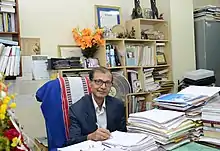Bidyut Baran Chaudhuri
Bidyut Baran Chaudhuri (B. B. Chauduri) is a senior computer scientist and the pro-vice-chancellor (academic) of Techno India University in West Bengal, India. He is also adjuncted to Indian Statistical Institute (ISI), where he was a professor for about three decades. He was the founding Head of Computer Vision and Pattern Recognition Unit (which was established in 1994) of ISI. Moreover, he was a J.C. Bose Fellow and INAE[1] Distinguished Professor at ISI.
Bidyut Baran Chaudhuri | |
|---|---|
| Bengali: বিদ্যুৎ বরণ চৌধুরী | |
 Chaudhuri in ISI at his Office, 2015 | |
| Born | 1950 (age 72–73) |
| Nationality | Indian |
| Alma mater | |
| Known for | |
| Awards |
|
| Scientific career | |
| Fields | Computer science |
| Institutions | Indian Statistical Institute |
| Website | www |
He was the vice-president of the Society for Natural Language Technology Research (SNLTR).[2]
His primary research contributes to the fields of computer vision, image processing and pattern recognition.[3] He is a pioneer of "Indian language script OCR".[3]
Education
Chaudhuri received his BSc (Hons.), BTech and MTech degrees from University of Calcutta, India in 1969, 1972 and 1974, respectively and PhD Degree from Indian Institute of Technology Kanpur in 1980.[1] He did his post-doc work during 1981-1982 from Queen's University, U.K, through Leverhulme Overseas Fellowship.
Awards and recognition
Chaudhuri has been elected as a Life Fellow of IEEE "for contributions to pattern recognition, especially Indian language script OCR, document processing and natural language processing".[3][4] He has become a Fellow of International Association for Pattern Recognition (IAPR) "for contributions to character recognition and speech synthesis in Indian language".[5] He is also Fellow of The World Academy of Science (TWAS),[6] Indian National Science Academy (INSA),[7] Indian National Academy of Engineering (INAE),[1] National Academy of Sciences (NASI),[8] and Institute of Electronics and Telecommunication Engineering (IETE). In 2011, Chaudhuri received the Om Prakash Bhasin Award for his contribution in the field of electronics and information technology.
Chaudhuri's interview on some of his works has been reported in Indian newspaper as well.[9][10]
He is within world's top 2% scientists and top-10 Indian AI scientists according to a study conducted by Stanford University.[11]
References
- "INAE Expert Pool". INAE. Retrieved 20 November 2018.
- "Society for Natural Language Technology Research". NLTR. Retrieved 20 November 2018.
- "IEEE Life Fellow Dictionary". IEEE. Retrieved 20 November 2018.
- "IEEE Fellows in IEEE Region 10 Kolkata Section". IEEE. Retrieved 20 November 2018.
- "IAPR Fellows". IAPR. Retrieved 20 November 2018.
- "TWAS Fellow". TWAS. Retrieved 20 November 2018.
- "INSA Fellow". INSA. Archived from the original on 4 March 2016. Retrieved 20 November 2018.
- "NASI Fellows". NASI. Archived from the original on 15 March 2016. Retrieved 20 January 2016.
- The Telegraph. "The Telegraph, India, Jan 29, 2004". Retrieved 20 November 2018.
- Jayanta Gupta (21 August 2013). "Now, software to decode Tagore's handwriting". The Times of India. TNN. Retrieved 20 November 2018.
- Ioannidis J.P.A., Boyack K.W., Baas J. "Updated science-wide author databases of standardized citation indicators. PLoS Biol 18(10): e3000918, 2020". doi:10.1371/journal.pbio.3000918.
{{cite news}}: CS1 maint: multiple names: authors list (link)
External links
- Bidyut Baran Chaudhuri publications indexed by Google Scholar
- ISI Official Homepage (old)
- INSA
- Books at Amazon
- Publications from DBLP